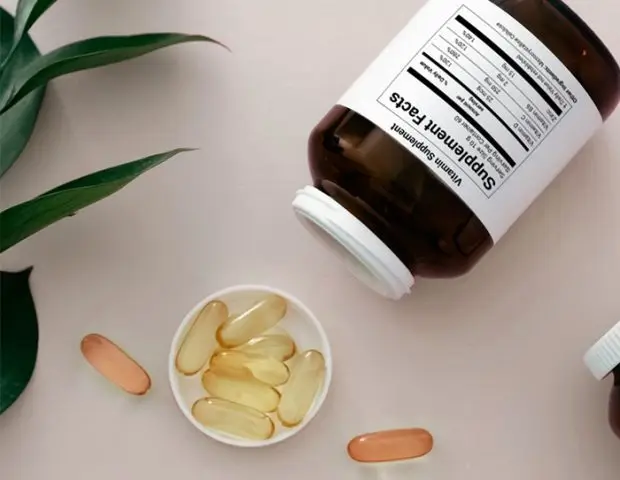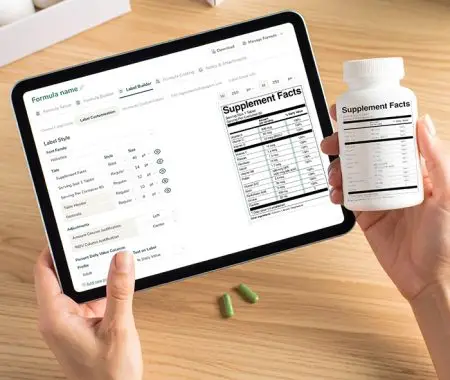As scientific as dietary supplement labeling may seem, the math behind it is a vital backbone of compliance and regulations. That’s where Rounding Rules come into play – a set of rules the FDA has issued for food manufacturers to follow for declaring nutrients on food products.
Supplement label requirements are established by the FDA to ensure consistency and transparency for consumers. At Food Label Maker, we simplify this process for you by integrating those regulations directly into our platform.
This article serves as the definitive guide to FDA supplement facts labeling rounding rules, ensuring complete compliance for all supplement manufacturers.
If you’d like to explore the Supplements Labeling & Formulation Software at Food Label Maker, book a demo today.
Formulate, Analyze, and Generate FDA-Compliant Supplement Labels

Supplement Facts Label: Rounding Rules Table
The table below outlines the rules for rounding nutrient values on supplement facts labels.
You can also download an FDA Rounding Rules Compliance Checklist to ensure that you are rounding correctly when creating your supplement facts label.
| Nutrient | Rounding Rule | Insignificant Amount |
| Calories Calories from Fat Calories from Saturated Fat | < 5 cal – round as 0 ≤50 cal – round to nearest 5 cal increment > 50 cal – round to nearest 10 cal increment | < 5 cal |
| Total Fat Saturated Fat Trans Fat Polyunsaturated Fat Monounsaturated Fat | < 0.5 g – round as 0 < 5 g – round to nearest 0.5g increment ≥5 g – round to nearest 1 g increment | < 0.5 g |
| Cholesterol | < 2 mg – round as 0 2 – 5 mg – round as “less than 5 mg”> 5 mg – round to nearest 5 mg increment | < 2 mg |
| Sodium Potassium | < 5 mg – round as 0 5 – 140 mg – round to nearest 5 mg increment > 140 mg – round to nearest 10 mg increment | < 5 mg |
| Total Carbohydrate Dietary Fiber Sugars | < 0.5 g – round as 0 < 1 g – round as “Contains less than 1 g” or “less than 1 g” ≥1 g – round to nearest 1 g increment | < 1 g |
| Soluble and Insoluble Fiber Sugar Alcohol Other Carbohydrate | < 0.5 g – round as 0 < 1 g – round as “Contains less than 1 g “ or “less than 1 g” ≥1 g – express to nearest 1 g increment | < 0.5 g |
| Protein | < 0.5 g – round as 0 < 1 g – round as “Contains less than 1 g” or “less than 1 g” or to 1 g if 0.5 g to < 1 g ≥1 g – round to nearest 1 g increment | < 1 g |
| When declaring nutrients other than vitamins and minerals that have RDIs as a % DV | round to nearest 1% DV increment | < 1% DV |
| Vitamins & Minerals (% DV) | < 2% of RDI may be rounded in various ways (Refer to the FDA Food Labeling Guide for a more detailed explanation) ≤10% of RDI – round to nearest 2% DV increment > 10% – 50% of RDI – round to nearest 5% DV increment > 50% of RDI – round to nearest 10% DV increment | < 2% RDI |
| Servings per Container | round to nearest 0.5 |
Table information has been sourced from Appendix H of the FDA Food Labeling Guide:
Note: Keep these 2 points in mind for grams and %DV increments.
- Round up when a value is exactly halfway though, or higher than, 2 numbers.
- Round down when a value is less than halfway between two whole numbers.
Areas of Accuracy in Supplement Labeling
Adding Zero to Supplement Facts Labels
When listing nutrients on a Supplement Facts panel, a core difference from conventional food labeling (Nutrition Facts) is the treatment of values that round to zero.
The FDA generally prohibits adding “0” to nutrients in the Supplement Facts panel – often referred to as the “Omission of Zero” rule. Therefore, if the amount of a nutrient per serving is low enough to round down to zero (according to the specific supplement rounding rules 21 CFR 101.9(c)) that nutrient line must be omitted entirely from the supplement facts panel. This rule ensures clarity and avoids printing insignificant quantitative values.
For context, this contrasts sharply with the Nutrition Facts label for conventional food, where “zero” values are often required or permitted to be declared for certain nutrients to indicate their absence.
Protein Declaration on Supplement Facts Labels
When it comes to protein, the FDA states “Protein shall not be declared on labels of products that contain only individual amino acids (other than those added for technological reasons).” 21 CFR 101.36(b)(2)(i)
This means that if your product is a supplement composed only of individual amino acids, you do not do any protein rounding rules and should completely omit any protein listing from the label. The declaration of protein, and its’ rounding rules (1g increments), only apply when the supplement contains intact, functional protein (such as a whey or plant-based protein powder).
If the product is only amino acids, the “omission rule” applies immediately, and no rounding takes place for a protein value.
FDA Rounding Rules for Vitamins and Minerals
The tiered rounding system is the core of compliance for vitamins and minerals, ensuring consistency and transparency for consumers.
Building on the 2016 label updates for nutrition panels, the FDA also confirmed that the display of specific quantitative amounts (mg or mcg) is required on the Supplement Facts label.
The tables below (from the FDA under Nutrition and Supplement Facts Labels: Questions and Answers Related to the Compliance Date, Added Sugars, and Declaration of Quantitative Amounts of Vitamins and Minerals: Guidance for Industry) detail how to declare vitamins and minerals on supplement facts labels.
| Nutrient | Recommended Increment |
| Vitamin A | Nearest 10 mcg |
| Vitamin C | Nearest mg |
| Calcium * | Nearest 10 mg |
| Iron * | Nearest .1 mg |
| Vitamin D * | Nearest .1 mcg |
| Vitamin E | Nearest .1 mg |
| Vitamin K | Nearest mcg |
| Thiamin | Nearest .01 mg |
| Riboflavin | Nearest .01 mg |
| Niacin | Nearest .1 mg |
| Vitamin B6 | Nearest .01 mg |
| Folate | Nearest 5 mcg |
| Vitamin B12 | Nearest .01 mcg |
| Biotin | Nearest .1 mcg |
| Pantothenic acid | Nearest .1 mg |
| Phosphorus | Nearest 10 mg |
| Iodine | Nearest mcg |
| Magnesium | Nearest 5 mg |
| Zinc | Nearest .1 mg |
| Selenium | Nearest mcg |
| Copper | Nearest .01 mg |
| Manganese | Nearest .01 mg |
| Chromium | Nearest .1 mcg |
| Molybdenum | Nearest .1 mcg |
| Chloride | Nearest 10 mg |
| Potassium * | Nearest 10 mg |
| Choline | Nearest 10 mg |
* mandatory vitamin/mineral that must be mentioned on both nutrition facts and supplement facts labels
| Nutrient | Rounding Rule | Insignificant Amount |
| General | Based on units of measurement and levels of significance from the RDI table. | Zeros after decimal points can be dropped. Additional decimal places can be used if needed for accuracy. |
| Less than 2% of RDI | Not required to be declared on the Supplements Facts label. | If the nutrient’s actual level is zero (0) after applying the general rounding rules, it must be omitted from the label (Rule of Omission). |
| Dietary Supplements | Must declare vitamin D, calcium, iron, and potassium regardless of amount, unless the Rule of Omission is applied (i.e., the amount is zero after rounding). | |
| RDI < 5 mg or mcg | Round to the nearest hundredth of a mg or mcg per serving. | Applies to thiamin, riboflavin, vitamin B6, vitamin B12, copper, and manganese. |
| RDI 5-50 mg or mcg | Round to the nearest tenth of a mg or mcg per serving. | Applies to iron, vitamin D, vitamin E, niacin, biotin, pantothenic acid, zinc, chromium, and molybdenum. |
| RDI 50-250 mg or mcg | Round to the nearest mg or mcg per serving. | Applies to vitamin C, vitamin K, iodine, and selenium. |
| RDI 250-500 mg or mcg | Round to the nearest 5 mg or mcg per serving. | Applies to folate and magnesium. |
| RDI 500 mg or mcg or greater | Round to the nearest 10 mg or mcg per serving. | Applies to vitamin A, calcium, phosphorus, chloride, potassium, and choline. |
| All nutrients except protein | Calculate the percent DV. | Manufacturers can use either the declared amount or the actual amount before rounding for consistency. |
Rounding Rules for Supplement Forms
The FDA rounding rules must be applied consistently regardless of the physical form your dietary supplement takes. Whether you manufacture a tiny capsule containing highly concentrated vitamins or a large scoop of protein powder, the final declarations on your Supplement Facts label must remain compliant.
This means manufacturers must apply the same specific rounding increments for total fat, carbohydrates, and minerals.
These rules are governed by the specific requirements for dietary supplements outlined in 21 CFR 101.36
The form of the product may influence the ingredient profile (e.g., fillers, binders, or solvents), but it does not change the mathematical rules used to declare the required nutrients per serving.

Key Points To Consider
While the rounding rules are universal, manufacturers should be mindful of a few form-specific points:
- Protein Powders: The form of protein is critical here. As we mentioned earlier, the declaration of Protein (and its associated rounding rules) must be omitted entirely if the product contains only individual amino acids, applying the Rule of Omission immediately, regardless of what the calculated value might be. Listing “Protein” could mislead consumers about the product’s actual dietary function.
- Pills and Capsules: For these highly concentrated forms, the serving size (often 1 or more capsules/pills) is fixed, and the focus remains solely on accurately applying the rounding rules to the typically small quantitative amounts of vitamins and minerals contained within that serving.
- Liquids and Drops: Since the serving size is often measured by volume (e.g., dropperfuls or milliliters), manufacturers must ensure the nutrient content used for rounding calculations is precisely representative of the declared volume, as slight variations in viscosity or dispensing can impact the quantitative value.
Simplifying FDA Rounding Rules with Supplements Labeling Software
Navigating the granular details of the FDA’s tiered rounding rules can be one of the most challenging aspects of supplement manufacturing compliance. From quantitative values and % DV increments to the complex Rule of Omission for zero values – these regulations are often layered with information making it difficult to keep up with technicalities, all whilst running a successful business.
However, these complex regulations don’t have to be a constant source of stress. At Food Label Maker, we’ve integrated the specific requirements of 21 CFR 101.36 directly into our supplement labeling and formulation software, reducing the stressful and tedious process of manual calculations.
With our tool you’ll get:
- Automated Rounding: The software automatically applies the correct tiered rounding for every nutrient, eliminating manual calculations and ensuring adherence to the smallest acceptable increment.
- Real-time Regulatory Updates: We ensure you’re always working with the most recent FDA guidelines, preventing non-compliance due to outdated rules.
- Error Reduction: By processing ingredient data through a verified database, it minimizes the risk of errors in the Supplement Facts panel.
In conclusion, the FDA’s rounding rules are essential for maintaining transparency and consistency for consumers. But rather than spending valuable hours manually cross-referencing tables and worrying about tiny rounding increments, modern nutrition analysis software offers an invaluable, streamlined pathway to compliance. By embracing these tools, you can ensure your labels are both perfectly compliant and exceptionally clear to your consumers.
Ready to ensure your next supplement label is fully compliant in minutes? Book a demo with us at Food Label Maker.
Frequently Asked Questions
How do I know if my Supplements Facts Label is compliant with FDA regulations?
At Food Label Maker, we fully integrate the FDA regulations for supplements facts labeling into our software. We provide fully FDA-compliant supplement facts labels that then need to be approved by the FDA.
According to the FDA, a composite of 12 subsamples (consumer packages) or 10 percent of the number of packages in the same inspection lot, will be randomly collected and inspected for compliance to 21 CFR 101.36(f)(1).
To get started, book a demo with our team and you’ll be guided through every step of the process.
What is the rule of omission in supplements facts labeling?
The Rule of Omission is not an official, codified term found in the Federal Food, Drug, and Cosmetic Act (FFDCA) or the U.S. Food and Drug Administration (FDA) regulations.
It’s actually a type of industry jargon that was created as a shorthand for the regulation that states that certain mandatory nutrients “shall not be declared” if they are not present or are present in amounts that can be declared as “zero”.
To get started, book a demo and see how you can create FDA-compliant supplement facts labels easily.
Can I create a supplements facts label for whey protein powder?
Yes you can.
The labeling for whey protein powder can be either a Supplement Facts panel or a Nutrition Facts panel, depending on how the product is marketed and categorized by the manufacturer under FDA guidelines.
The majority of whey protein powder is marketed as a dietary supplement, intended to supplement the diet by increasing total dietary intake, rather than being a conventional food item. The supplement facts label must include a disclaimer at the bottom if any “structure/function” claims are made.
If you’d like more information, book a demo and one of our account managers will lead you through the process.



